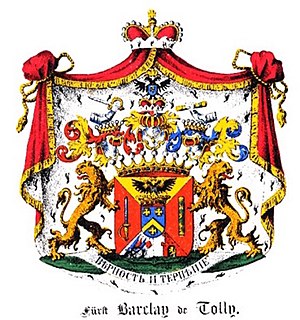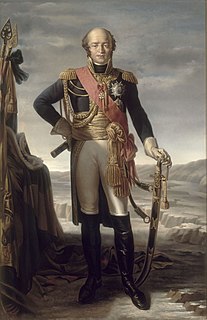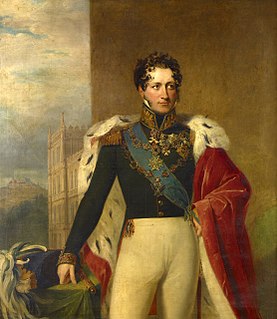 W
WAlbert was the King of Saxony and a member of the House of Wettin.
 W
WAlexander, Prince of Saxe-Gessaphe, is the adopted son and heir of Maria Emanuel, Margrave of Meissen, and a businessman with Lebanese, Mexican and German roots. Following the death of Maria Emanuel in July 2012 he assumed the headship of the Royal House of Saxony, based on a 1997 agreement that named him heir, but which was repudiated a few years later by a number of signatories. His claim is disputed by his cousin Prince Rüdiger of Saxony.
 W
WPrince Michael Andreas Barclay de Tolly was a Baltic German field marshal and Minister of War of the Russian Empire during Napoleon's invasion in 1812 and the War of the Sixth Coalition. Barclay implemented a number of reforms during this time that improved supply system in the army, doubled the number of army troops, and implemented new combat training principles. He was also the Governor-General of Finland.
 W
WPrince Carl Bernhard of Saxe-Weimar-Eisenach was a distinguished soldier, who, in 1815, after the congress of Vienna, became colonel of a regiment in the service of the king of the Netherlands. He fought at the Battle of Quatre Bras and the Battle of Waterloo where he commanded the 2nd Brigade of the 2nd Dutch Division and became a Chief Commander of the Royal Netherlands East Indies Army
 W
WCharles I or Karl I was the last Emperor of Austria, the last King of Hungary, the last King of Croatia, last King of Bohemia, and the last monarch belonging to the House of Habsburg-Lorraine before the dissolution of Austria-Hungary. The son of Archduke Otto of Austria and Princess Maria Josepha of Saxony, Charles became heir presumptive of Emperor Franz Joseph after his uncle Archduke Franz Ferdinand of Austria was assassinated in 1914. In 1911, he married Princess Zita of Bourbon-Parma.
 W
WCharles XIV John was King of Sweden and Norway from 1818 until his death. In modern Norwegian lists of kings he is called Charles III John. He was the first monarch of the Bernadotte dynasty.
 W
WLouis-Nicolas d'Avout, better known as Davout, 1st Duke of Auerstaedt, 1st Prince of Eckmühl, was a French military commander and Marshal of the Empire who served during both the French Revolutionary Wars and the Napoleonic Wars. His talent for war along with his reputation as a stern disciplinarian earned him the nickname "The Iron Marshal". He is ranked along with Marshals André Masséna and Jean Lannes as one of Napoleon's finest commanders. His loyalty and obedience to Napoleon were absolute. During his lifetime, Davout's name was commonly spelled Davoust, which is how it appears on the Arc de Triomphe and in much of the correspondence between Napoleon and his generals.
 W
WErnest I was the last sovereign duke of Saxe-Coburg-Saalfeld and, from 1826, the first sovereign duke of Saxe-Coburg and Gotha. He was the father of Albert, Prince Consort, who was the husband of Queen Victoria. Ernest fought against Napoleon Bonaparte, and through construction projects and the establishment of a court theatre, he left a strong imprint on his residence town, Coburg.
 W
WFranz Joseph I or Francis Joseph I was Emperor of Austria, King of Hungary, Croatia, and Bohemia, and monarch of other states of the Austro-Hungarian Empire, from 2 December 1848 until his death. From 1 May 1850 to 24 August 1866 he was also President of the German Confederation. He was the longest-reigning ruler of Austria and Hungary, as well as the sixth-longest-reigning monarch of any country in European history.
 W
WFrederick Augustus II was King of Saxony and a member of the House of Wettin.
 W
WFrederick Augustus III, and a member of the House of Wettin, was the last King of Saxony (1904–1918). Born in Dresden, Frederick Augustus was the eldest son of King George of Saxony and his wife, Maria Anna of Portugal.
 W
WFrederick III was German Emperor and King of Prussia for ninety-nine days in 1888, the Year of the Three Emperors. Known informally as "Fritz", he was the only son of Emperor Wilhelm I and was raised in his family's tradition of military service. Although celebrated as a young man for his leadership and successes during the Second Schleswig, Austro-Prussian and Franco-Prussian wars, he nevertheless professed a hatred of warfare and was praised by friends and enemies alike for his humane conduct. Following the unification of Germany in 1871 his father, then King of Prussia, became the German Emperor. Upon Wilhelm's death at the age of ninety on 9 March 1888, the thrones passed to Frederick, who had by then been German Crown Prince for seventeen years and Crown Prince of Prussia for twenty-seven years. Frederick was suffering from cancer of the larynx when he died, aged fifty-six, following unsuccessful medical treatments for his condition.
 W
WPrince Friedrich Karl of Prussia was the son of Prince Charles of Prussia (1801–1883) and his wife, Princess Marie of Saxe-Weimar-Eisenach (1808–1877). Prince Friedrich Karl was a grandson of King Frederick William III of Prussia and a nephew of Frederick William IV and William I. He was born in Berlin at the Royal Palace.
 W
WGeorge was a King of Saxony of the House of Wettin.
 W
WPaul Ludwig Hans Anton von Beneckendorff und von Hindenburg, typically known simply as Paul von Hindenburg, was a German general and statesman who led the Imperial German Army during World War I and later became President of Germany from 1925 until his death during the Weimar Republic. During his presidency, he played a key role in the Nazi Machtergreifung in January 1933 when, under pressure from advisers, he appointed Adolf Hitler as Chancellor of Germany.
 W
WGraf Helmuth Karl Bernhard von Moltke was a Prussian field marshal. The chief of staff of the Prussian Army for thirty years, he is regarded as the creator of a new, more modern method of directing armies in the field. He commanded troops in Europe and the Middle East, commanding during the Second Schleswig War, Austro-Prussian War and the Franco-Prussian War. He is described as embodying "Prussian military organization and tactical genius." He was fascinated with railways and pioneered their military usage. He is often referred to as Moltke the Elder to distinguish him from his nephew Helmuth Johann Ludwig von Moltke, who commanded the German Army at the outbreak of World War I.
 W
WRupprecht, Crown Prince of Bavaria, Duke of Bavaria, Franconia and in Swabia, Count Palatine by (the) Rhine was the last heir apparent to the Bavarian throne. During the first half of the First World War he commanded the 6th Army on the Western Front. From August 1916, he commanded Army Group Rupprecht of Bavaria, which occupied the sector of the front opposite the British Expeditionary Force.
 W
WWilhelm II, anglicised as William II, was the last German Emperor (Kaiser) and King of Prussia. His reign lasted from 15 June 1888 to 9 November 1918. Despite strengthening Germany’s position as a great power by building a blue-water navy and promoting scientific innovation, his tactless public statements and reckless foreign policy greatly antagonized the international community and ultimately plunged his country into World War I. When the German war effort collapsed after a series of crushing defeats on the Western Front in 1918, he was forced to abdicate, thereby bringing an end to the Hohenzollern dynasty’s three hundred year rule.
 W
WWilhelm, German Crown Prince was the eldest child and heir of the last German Emperor, Wilhelm II, and the last Crown Prince of the German Empire and the Kingdom of Prussia. After the death of his grandfather Emperor Frederick III, Wilhelm became crown prince at the age of six, retaining that title for more than 30 years until the fall of the empire on 9 November 1918. During World War I, he commanded the 5th Army from 1914 to 1916 and was commander of the Army Group German Crown Prince for the remainder of the war. Crown Prince Wilhelm became head of the House of Hohenzollern on 4 June 1941 following the death of his father and held the position until his own death on 20 July 1951.
 W
WWilliam I or Wilhelm I of the House of Hohenzollern was King of Prussia from 2 January 1861 and the first German Emperor from 18 January 1871 to his death. William was the first head of state of a united Germany, and was also de facto head of state of Prussia from 1858 to 1861, serving as regent for his brother, Frederick William IV.
 W
WWilliam II was the last King of Württemberg. He ruled from 6 October 1891 until the abolition of the kingdom on 30 November 1918.